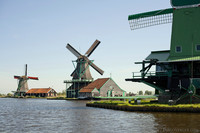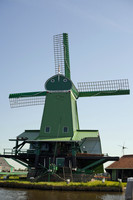Zaanse Schans, a Dutch cultural site
A Dutch cultural site that reproduces the living conditions of a traditional town in the Zaan region (Zaanstreek) during the 18th and 19th centuries.
Zaanse Schans windmills
 The traditional Dutch windmills have been placed along the bank of the Zaan River. All of these windmills are not only a tourist attraction, but are actually functional and each of them processes specific raw materials, such as pigments, spices or wood.
The traditional Dutch windmills have been placed along the bank of the Zaan River. All of these windmills are not only a tourist attraction, but are actually functional and each of them processes specific raw materials, such as pigments, spices or wood.
Houses of Zaanse Schans
 All the houses, stores and windmills have been transferred from various parts of the Zaan region to create Zaanse Schans in the 1960s, with authentic buildings.
All the houses, stores and windmills have been transferred from various parts of the Zaan region to create Zaanse Schans in the 1960s, with authentic buildings.
The clog workshop of Zaanse Schans
 From the cheese and chocolate factories to the clog workshop, most stores in Zaanse Schans allow not only acquiring various artisan products but also seeing demonstrations, such as how clogs ("klompen") are made.
From the cheese and chocolate factories to the clog workshop, most stores in Zaanse Schans allow not only acquiring various artisan products but also seeing demonstrations, such as how clogs ("klompen") are made.
De Gekroonde Poelenburg and Verfmolen De Kat
 On the left, the sawmill Gekroonde Poelenburg from 1867, which proceeds from Koog aan de Zaan, to the southwest of Zaanse Schans. In the background, the windmill in the center of the picture is known as De Kat (the Cat), and was built in 1664. This windmill is a "Verfmolen", or paint mill, which grinds pigments for the manufacture of paint.
On the left, the sawmill Gekroonde Poelenburg from 1867, which proceeds from Koog aan de Zaan, to the southwest of Zaanse Schans. In the background, the windmill in the center of the picture is known as De Kat (the Cat), and was built in 1664. This windmill is a "Verfmolen", or paint mill, which grinds pigments for the manufacture of paint.
Machinery used to manufacture clogs
 On the right, a German machine that the artisans use to sculpt the external shape of clogs from a wooden block. This is a veritable clogs copier that rotates and carves the wooden bock imitating the shape of any other clog used as a reference model. On the left, a French machine that is used to drill and carve the clog’s interior.
On the right, a German machine that the artisans use to sculpt the external shape of clogs from a wooden block. This is a veritable clogs copier that rotates and carves the wooden bock imitating the shape of any other clog used as a reference model. On the left, a French machine that is used to drill and carve the clog’s interior.
Side view of the machinery used to manufacture clogs
 In the German machine on the right you can see a clog just "copied". The next step will be to drill the interior with the French machine, and then the artisan must finish carving the piece by hand, and let the wood dry, which exudes water, before painting it or adding external details.
In the German machine on the right you can see a clog just "copied". The next step will be to drill the interior with the French machine, and then the artisan must finish carving the piece by hand, and let the wood dry, which exudes water, before painting it or adding external details.
Media (36)
 Zaanse Schans windmills
Zaanse Schans windmills
 Houses of Zaanse Schans
Houses of Zaanse Schans
 Canals bordering the gardens of the traditional Dutch houses
Canals bordering the gardens of the traditional Dutch houses
 The clog workshop of Zaanse Schans
The clog workshop of Zaanse Schans
 The rush mat factory of Zaanse Schans
The rush mat factory of Zaanse Schans
 De Gekroonde Poelenburg and Verfmolen De Kat
De Gekroonde Poelenburg and Verfmolen De Kat
 Garden of the sundial in Zaanse Schans
Garden of the sundial in Zaanse Schans
 Workshops and stores immersed in nature
Workshops and stores immersed in nature
 Houses and gardens of Zaanse Schans
Houses and gardens of Zaanse Schans
 Detail of the clogs exhibited inside the clog workshop of Zaanse Schans
Machinery used to manufacture clogs - Zaanse Schans, a Dutch cultural site
Machinery used to manufacture clogs
Side view of the machinery used to manufacture clogs - Zaanse Schans, a Dutch cultural site
Side view of the machinery used to manufacture clogs
The sundial garden - Zaanse Schans, a Dutch cultural site
The sundial garden
Scenery of Zaanse Schans - Zaanse Schans, a Dutch cultural site
Scenery of Zaanse Schans
Sheep grazing in one of the meadows of Zaanse Schans - Zaanse Schans, a Dutch cultural site
Sheep grazing in one of the meadows of Zaanse Schans
Zaanse Schans is no place for stress - Zaanse Schans, a Dutch cultural site
Zaanse Schans is no place for stress
Birds of Zaanse Schans - Zaanse Schans, a Dutch cultural site
Birds of Zaanse Schans
Ducks next to a canal and houses of Zaanse Schans - Zaanse Schans, a Dutch cultural site
Ducks next to a canal and houses of Zaanse Schans
Child clogs - Zaanse Schans, a Dutch cultural site
Child clogs
Clog models exhibited in the clog workshop - Zaanse Schans, a Dutch cultural site
Clog models exhibited in the clog workshop
The diamond clog - Zaanse Schans, a Dutch cultural site
The diamond clog
Clogs sculpted with sacred geometry - Zaanse Schans, a Dutch cultural site
Clogs sculpted with sacred geometry
Clog-inspired violins - Zaanse Schans, a Dutch cultural site
Clog-inspired violins
Clogs for walking on ice used by fishermen - Zaanse Schans, a Dutch cultural site
Clogs for walking on ice used by fishermen
Clogs sculpted with geometric shapes - Zaanse Schans, a Dutch cultural site
Clogs sculpted with geometric shapes
Giant clogs - Zaanse Schans, a Dutch cultural site
Giant clogs
Skiing clogs - Zaanse Schans, a Dutch cultural site
Skiing clogs
Clogs sculpted with plant motifs - Zaanse Schans, a Dutch cultural site
Clogs sculpted with plant motifs
Clogs for horses and for working on the fields - Zaanse Schans, a Dutch cultural site
Clogs for horses and for working on the fields
Clogs made by the French artisan Pascal Jusot - Zaanse Schans, a Dutch cultural site
Clogs made by the French artisan Pascal Jusot
The Huisman - Zaanse Schans, a Dutch cultural site
The Huisman
The windmills De Gekroonde Poelenburg and De Kat - Zaanse Schans, a Dutch cultural site
The windmills De Gekroonde Poelenburg and De Kat
The Gekroonde Poelenburg in Zaanse Schans - Zaanse Schans, a Dutch cultural site
The Gekroonde Poelenburg in Zaanse Schans
Sheep grazing next to a canal in Zaanse Schans - Zaanse Schans, a Dutch cultural site
Sheep grazing next to a canal in Zaanse Schans
Canals and access bridges to some buildings in Zaanse Schans - Zaanse Schans, a Dutch cultural site
Canals and access bridges to some buildings in Zaanse Schans
Three of the windmills of Zaanse Schans - Zaanse Schans, a Dutch cultural site
Three of the windmills of Zaanse Schans
Detail of the clogs exhibited inside the clog workshop of Zaanse Schans
Machinery used to manufacture clogs - Zaanse Schans, a Dutch cultural site
Machinery used to manufacture clogs
Side view of the machinery used to manufacture clogs - Zaanse Schans, a Dutch cultural site
Side view of the machinery used to manufacture clogs
The sundial garden - Zaanse Schans, a Dutch cultural site
The sundial garden
Scenery of Zaanse Schans - Zaanse Schans, a Dutch cultural site
Scenery of Zaanse Schans
Sheep grazing in one of the meadows of Zaanse Schans - Zaanse Schans, a Dutch cultural site
Sheep grazing in one of the meadows of Zaanse Schans
Zaanse Schans is no place for stress - Zaanse Schans, a Dutch cultural site
Zaanse Schans is no place for stress
Birds of Zaanse Schans - Zaanse Schans, a Dutch cultural site
Birds of Zaanse Schans
Ducks next to a canal and houses of Zaanse Schans - Zaanse Schans, a Dutch cultural site
Ducks next to a canal and houses of Zaanse Schans
Child clogs - Zaanse Schans, a Dutch cultural site
Child clogs
Clog models exhibited in the clog workshop - Zaanse Schans, a Dutch cultural site
Clog models exhibited in the clog workshop
The diamond clog - Zaanse Schans, a Dutch cultural site
The diamond clog
Clogs sculpted with sacred geometry - Zaanse Schans, a Dutch cultural site
Clogs sculpted with sacred geometry
Clog-inspired violins - Zaanse Schans, a Dutch cultural site
Clog-inspired violins
Clogs for walking on ice used by fishermen - Zaanse Schans, a Dutch cultural site
Clogs for walking on ice used by fishermen
Clogs sculpted with geometric shapes - Zaanse Schans, a Dutch cultural site
Clogs sculpted with geometric shapes
Giant clogs - Zaanse Schans, a Dutch cultural site
Giant clogs
Skiing clogs - Zaanse Schans, a Dutch cultural site
Skiing clogs
Clogs sculpted with plant motifs - Zaanse Schans, a Dutch cultural site
Clogs sculpted with plant motifs
Clogs for horses and for working on the fields - Zaanse Schans, a Dutch cultural site
Clogs for horses and for working on the fields
Clogs made by the French artisan Pascal Jusot - Zaanse Schans, a Dutch cultural site
Clogs made by the French artisan Pascal Jusot
The Huisman - Zaanse Schans, a Dutch cultural site
The Huisman
The windmills De Gekroonde Poelenburg and De Kat - Zaanse Schans, a Dutch cultural site
The windmills De Gekroonde Poelenburg and De Kat
The Gekroonde Poelenburg in Zaanse Schans - Zaanse Schans, a Dutch cultural site
The Gekroonde Poelenburg in Zaanse Schans
Sheep grazing next to a canal in Zaanse Schans - Zaanse Schans, a Dutch cultural site
Sheep grazing next to a canal in Zaanse Schans
Canals and access bridges to some buildings in Zaanse Schans - Zaanse Schans, a Dutch cultural site
Canals and access bridges to some buildings in Zaanse Schans
Three of the windmills of Zaanse Schans - Zaanse Schans, a Dutch cultural site
Three of the windmills of Zaanse Schans





























